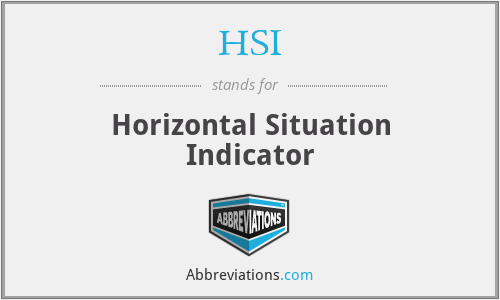What does HSI mean in NASA?
This page is about the meanings of the acronym/abbreviation/shorthand HSI in the Governmental field in general and in the NASA terminology in particular.
Horizontal Situation Indicator
Translation
Find a translation for Horizontal Situation Indicator in other languages:
Select another language:
- - Select -
- 简体中文 (Chinese - Simplified)
- 繁體中文 (Chinese - Traditional)
- Español (Spanish)
- Esperanto (Esperanto)
- 日本語 (Japanese)
- Português (Portuguese)
- Deutsch (German)
- العربية (Arabic)
- Français (French)
- Русский (Russian)
- ಕನ್ನಡ (Kannada)
- 한국어 (Korean)
- עברית (Hebrew)
- Gaeilge (Irish)
- Українська (Ukrainian)
- اردو (Urdu)
- Magyar (Hungarian)
- मानक हिन्दी (Hindi)
- Indonesia (Indonesian)
- Italiano (Italian)
- தமிழ் (Tamil)
- Türkçe (Turkish)
- తెలుగు (Telugu)
- ภาษาไทย (Thai)
- Tiếng Việt (Vietnamese)
- Čeština (Czech)
- Polski (Polish)
- Bahasa Indonesia (Indonesian)
- Românește (Romanian)
- Nederlands (Dutch)
- Ελληνικά (Greek)
- Latinum (Latin)
- Svenska (Swedish)
- Dansk (Danish)
- Suomi (Finnish)
- فارسی (Persian)
- ייִדיש (Yiddish)
- հայերեն (Armenian)
- Norsk (Norwegian)
- English (English)
Definition
What does HSI mean?
- Horizontal situation indicator
- The horizontal situation indicator (commonly called the HSI) is an aircraft flight instrument normally mounted below the artificial horizon in place of a conventional heading indicator. It combines a heading indicator with a VHF omnidirectional range-instrument landing system (VOR-ILS) display. This reduces pilot workload by lessening the number of elements in the pilot's instrument scan to the six basic flight instruments. Among other advantages, the HSI offers freedom from the confusion of reverse sensing on an instrument landing system localizer back course approach. As long as the needle is set to the localizer front course, the instrument will indicate whether to fly left or right, in either direction of travel. On the HSI, the aircraft is represented by a schematic figure in the centre of the instrument – the VOR-ILS display is shown in relation to this figure. The heading indicator is usually slaved to a remote compass and the HSI is frequently interconnected with an autopilot capable of following the heading select bug and of executing an ILS approach by following the localizer and glide slope.On a conventional VOR indicator, left–right and to–from must be interpreted in the context of the selected course. When an HSI is tuned to a VOR station, left and right always mean left and right and TO/FROM is indicated by a simple triangular arrowhead pointing to the VOR. If the arrowhead points to the same side as the course selector arrow, it means TO, and if it points behind to the side opposite the course selector, it means FROM. The HSI illustrated here is a type designed for smaller airplanes and is the size of a standard 3 ¼-inch instrument. Airline and jet aircraft HSIs are larger and may include more display elements. The most modern HSI displays are electronic and often integrated with electronic flight instrument systems into so-called "glass cockpit" systems.
Popularity rank by frequency of use
How popular is HSI among other acronyms?
HSI#1#3422#12977
Embed
Citation
Use the citation below to add this abbreviation to your bibliography:
Style:MLAChicagoAPA
"HSI." Abbreviations.com. STANDS4 LLC, 2024. Web. 24 Apr. 2024. <https://www.abbreviations.com/term/562774>.



Discuss this HSI abbreviation with the community:
Report Comment
We're doing our best to make sure our content is useful, accurate and safe.
If by any chance you spot an inappropriate comment while navigating through our website please use this form to let us know, and we'll take care of it shortly.
Attachment
You need to be logged in to favorite.
Log In